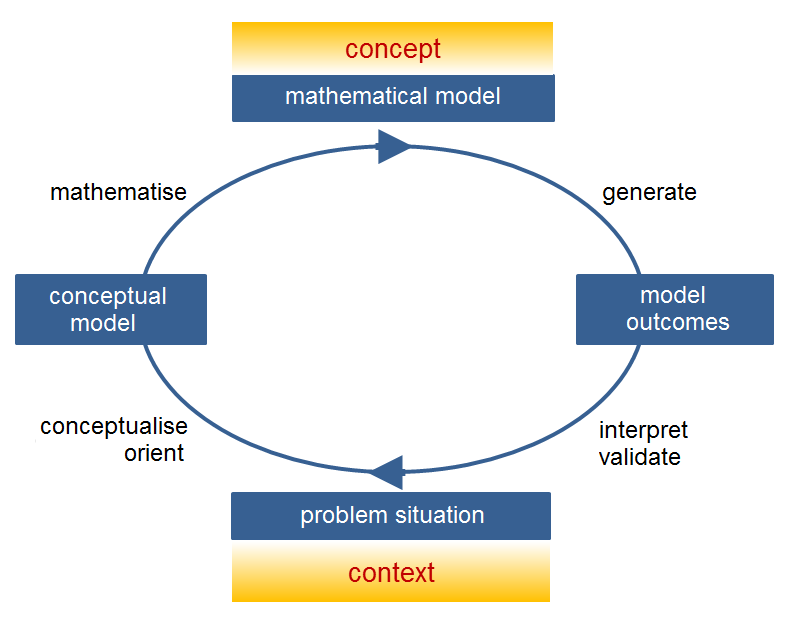2. Modelling in secondary education
2.2 Modelling cycle
Modelling is a core activity in (natural) science. Within the framework of modelling education at secondary school level, the learning objectives are:1,2 1.2 learning to recognize situations where familiar models play a role, learning how to construct models (pre-university level [vwo] only) and interpreting model results in the light of the problem posed.
These objectives can be achieved by systematically teaching students how to model. A tool to shape this is a schematic ordering of the modelling process as a cycle of activities as shown below.3,4

Fig 2.2 Modelling cycle
The following types of learning activities can be distinguished in the modelling cycle:
- Orientation
Problem definition; from a scientific perspective, modelling begins with asking a question about a situation in a certain context; this question is defined and specified to a problem definition that guides further model development; learning to use a modelling tool and to represent data and results in tables and graphs. - Conceptualisation
Conceptual modelling; the problem definition is visualised through a schematic drawing or a concept map; relevant variables in the system and their relations are identified. Data are collected and processed, preferably on the basis of own research, like an experiment or research of a phenomenon via a simulation or an online database. - Mathematisation
Translation of the conceptual model in mathematical terms; the problem is analysed and reduced; relevant equations are derived or graphically represented in an appropriate modelling environment. - Generation of outcomes
Solution of the mathematical model and generation of outcomes. The results are computed with appropriate initial values of variables and parameters in the model. One iteratively tests whether the model works as meant. - Interpretation
Retranslation of model outcomes to the problem situation; investigation whether the model fits the data and can reasonably explain observations; if needed, the accuracy of the model is determined, taking into account the uncertainties in the model parameters and numerical approximations. - Validation
Reflection on the model and the modelling process; checking whether the original problem has indeed been solved and which insight in the explored system or phenomenon has been gained; what are limitations of the model and what extensions can be thought of?
If desired, the cycle is repeated until the model gives a satisfying solution to the problem posed.
Each of these activities relates to one or more of the central learning objectives. Not all activities can (and must) be discussed in every lesson or series of lessons. It is important to continue to emphasise in every subject taught that model thinking is central in physics. By discussing over a number of school years the various aspects of learning about models and modelling, a balanced image of modelling can emerge.
Students benefit from a systematic structure of modelling instruction and from a systematic reflection on process steps and their outcomes. The modelling cycle structures a modelling learning strategy and its implementation in the form of a modelling learning path.5,6